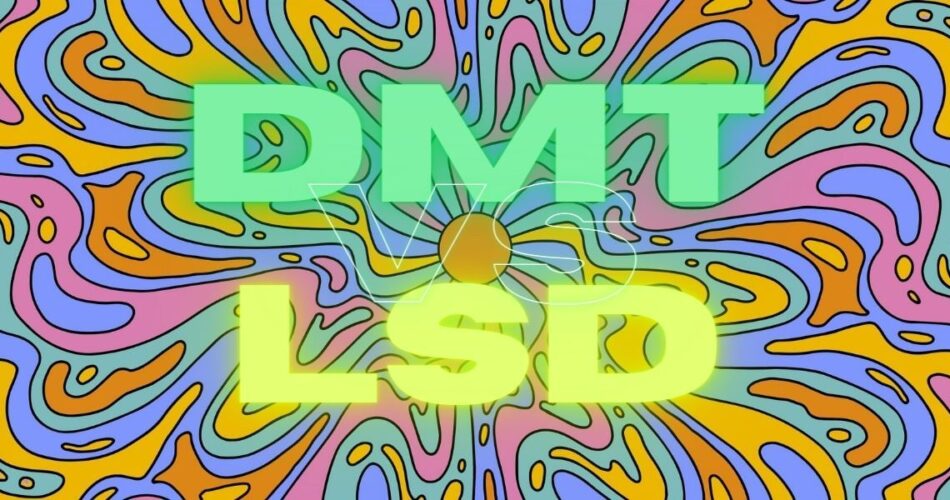DMT and LSD are two of the most powerful psychedelics on the planet, both capable of producing profoundly deep and meaningful experiences. What are the differences between DMT vs LSD? In this article, we’ll explore what DMT and LSD are, as well as the similarities and differences between them.
KEY TAKEAWAYS
- Psychedelic drugs work by altering the chemical balance in the brain, resulting in intense visual and auditory hallucinations.
- DMT vs LSD: The effects of DMT and LSD are similar, but there are some important differences to consider.
- DMT produces much shorter-lasting hallucinations than LSD.
- LSD is one of the most potent psychedelics on the planet, with a small dose producing intense effects that can last for up to 12 hours.
- DMT is also known for its spiritual and mystical qualities, while LSD is more focused on providing an altered perception of reality.
DMT: N-Dimethyltryptamine
Before we explain the differences between DMT vs LSD, let us first understand each substance. DMT (N-dimethyltryptamine) is a powerful psychedelic found naturally in some plants and is often referred to as “the spirit molecule.” DMT produces intense visual hallucinations and an altered state of consciousness, typically within minutes of consumption.
DMT’s effects are short-lived, lasting around 30 minutes if smoked and up to 4 hours when taken orally in a liquid form. DMT can be found in different forms, including DMT-based “brews” and ayahuasca.
What’s Ayahuasca?
Ayahuasca is traditionally used in shamanic rituals and has been used for thousands of years by people in the Amazon basin. The vine contains psychoactive compounds that produce powerful hallucinations when consumed. Ayahuasca is typically brewed into tea and drunk in small doses. People who drink ayahuasca often report having profound spiritual experiences, and the drug has been used in religious ceremonies by various cultures throughout history.
LSD: Lysergic Acid Diethylamide
LSD is a semisynthetic substance that was first synthesized in 1938 by a Swiss chemist, Albert Hofmann. It is derived from a compound found in ergot, a fungus that grows on rye and other grains. LSD is one of the most potent psychoactive substances known, with just a small dose (20-30 micrograms) producing profound effects that can last for up to 12 hours.
Effects of LSD include visual and auditory hallucinations, changes in perception and cognition, and altered states of consciousness. LSD is typically swallowed or taken orally, although it can also be injected, snorted, or smoked. So, what’s the difference between DMT vs LSD, and what do hallucinogens do to your brain?
Editor’s Note
DMT and LSD are not the only psychoactive substances that can have profound effects on the human mind. Other substances include psilocybin, ayahuasca, ketamine, and MDMA (ecstasy).
Each of these substances has different effects on the mind and body, which can range from intense euphoria to deep introspection. However, they all have some potential risks associated with their use, including psychological disturbances such as anxiety and paranoia as well as physical side effects.
How do Hallucinogenic Drugs Work?
There are many psychedelic drugs known today: DMT, LSD, psilocybin, and ketamine among others. These drugs work by altering the chemical balance in the brain. Serotonin and other chemical messengers, known as neurotransmitters, play an important role in various cognitive processes. Psychedelics are thought to disrupt the way these neurotransmitters interact with each other, resulting in intense visual and auditory hallucinations. But what’s the difference between DMT vs LSD?

DMT vs LSD: Differences Between These Two Hallucinogens
So, what are the differences between DMT vs LSD? The effects of DMT and LSD are similar, but there are some important differences to consider. DMT produces much shorter-lasting hallucinations than LSD. LSD is one of the most potent psychedelics on the planet, with a small dose producing intense effects that can last for up to 12 hours. DMT is also known for its spiritual and mystical qualities, while LSD is more focused on providing an altered perception of reality.
Another difference between DMT vs LSD is that DMT is typically consumed in the form of DMT-based “brews” or ayahuasca, while LSD can be swallowed, injected, snorted, or smoked.
Ultimately, DMT and LSD are both powerful psychedelics capable of producing profound experiences. It’s important to remember that both DMT and LSD can be dangerous if not used responsibly, and both are illicit in most countries.
Psychedelic Substances: Conclusion
DMT and LSD are two of the most powerful psychedelics known to man, each capable of producing profound experiences. People who use DMT or LSD need to be aware of the risks and always use these drugs responsibly. DMT and LSD offer different types of experiences, so it’s important to be aware of the differences between them before taking either drug. Ultimately, DMT and LSD can both produce powerful altered states, but it’s important to remember that they are illicit substances and should always be used with caution.
Long-term effects of hallucinogen use can be difficult to predict because they depend on the frequency and intensity of use, as well as the specific drug involved. However, some of the most common effects include changes in mood, perception, and cognitive function. While both DMT and LSD are not associated with physical addiction, they can lead to psychological dependence and shouldn’t be used recreationally.
Similar Posts:
- DMT Trip Visuals: How N-Dimethyltryptamine Alters Your Perception
- Mescaline vs. LSD – Let’s Compare These Popular Hallucinogens
- Changa: an Elevated DMT (Ayahuasca) and MAOI Mix
- Kratom and Shrooms: Two Psychoactive Substances of Natural Origin
- LSD Dosage Guide: The Right Dose of LSD
- PCP vs LSD: The Difference Between These Two Hallucinogens
- Shrooms vs. Acid: What Are the Similarities and Differences Between Magic Mushrooms and LSD (Acid)?




